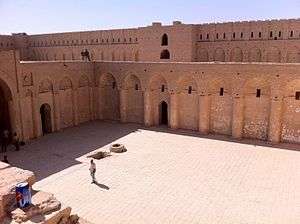Al-Ukhaidir Fortress
| Al-Ukhaidir Fortress حصن الأخيضر | |
|---|---|
| Karbala Governorate, Iraq | |
 Al-Ukhaidir Fortress near Karbala in Iraq | |
 Al-Ukhaidir Fortress حصن الأخيضر | |
| Coordinates | 32°26′26″N 43°36′08″E / 32.440556°N 43.602222°E |
| Type | Castle |

The Fortress of Al-Ukhaidir or Abbasid palace of Ukhaider is located roughly 50 km south of Karbala, Iraq. It is a large, rectangular fortress erected in 775 AD with a unique defensive style. Constructed by the Abbasid caliph As-Saffah's nephew Isa ibn Musa,[1] Ukhaidir represents Abbasid architectural innovation in the structures of its courtyards, residences and mosque. Excavations at Ukhaidir were conducted in the early 20th century by Gertrude Bell. Ukhaidir was an important stop on regional trade routes, similar to Atshan and Mujdah.[2] The complex comprises a primary hall, a large Iwan, a reception hall and servants quarters.[2] The fortress exemplifies Abbasid architecture in Iraq by demonstrating the "despotic and the pleasure-loving character of the dynasty" in its grand size but cramped living quarters.[3]
Marcel-Auguste Dieulafoy and Louis Massignon believed that the fortress used to be a pre-Islamic winter palace, built by an Iranian architect for the prince of Al-Hira. Therefore, it could be the renowned Qasr al-Sadir. The current name could be related to Isma'il ibn Yusuf al-Ukhaidhir from Banu Ukhaidhir who launched a rebellion against the Abbasid, then later he became the governor of Kufa with the support of Qarmatians.[4]
World Heritage Status
This site was added to the UNESCO World Heritage Tentative List on July 7, 2000 in the Cultural category.[2]
Notes
- ↑ http://www.al-monitor.com/pulse/originals/2015/12/iraq-karbala-ukhaidir-palace-neglect-history.html
- 1 2 3 The Fortress of Al-Ukhaidar - UNESCO World Heritage Centre
- ↑ Hillenbrand (1999).
- ↑ Houtsma, M. Th. (1993). E.J. Brill's first encyclopaedia of Islam, 1913-1936. Leiden ; New York : E.J. Brill. p. 994. ISBN 9004097961.
References
- Ukhaidir (Iraq) - About.com Accessed 2009-09-25.
- Hillenbrand, R (1999), Islamic Art and Architecture, Thames and Hudson, 1999. ISBN 0-500-20305-9
Coordinates: 32°26′26″N 43°36′08″E / 32.44056°N 43.60222°E